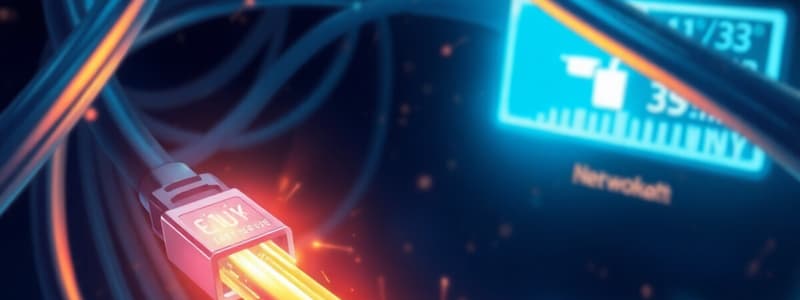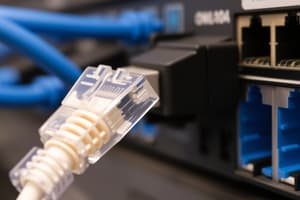Podcast
Questions and Answers
What is the primary difference between 10Mb/s and 100Mb/s Ethernet?
What is the primary difference between 10Mb/s and 100Mb/s Ethernet?
- The type of physical media used
- The length of the cable required
- The number of bits transmitted per second (correct)
- The type of connectors used
What does goodput measure in a network?
What does goodput measure in a network?
- The total throughput of the network
- The specified bandwidth in physical layer implementations
- Throughput plus session establishment time
- Throughput minus traffic overhead (correct)
What does attenuation refer to in the context of copper cabling?
What does attenuation refer to in the context of copper cabling?
- The interference from external electromagnetic fields
- The deterioration of the signal over distance (correct)
- The strength of the copper cable structure
- The ability to transmit data quickly
What is a common use of Unshielded Twisted-Pair (UTP) cabling?
What is a common use of Unshielded Twisted-Pair (UTP) cabling?
What type of interference do the twisted wires in UTP cabling primarily help to prevent?
What type of interference do the twisted wires in UTP cabling primarily help to prevent?
Which of the following is NOT a characteristic of copper media?
Which of the following is NOT a characteristic of copper media?
Which of the following factors does NOT typically result in throughput not matching the specified bandwidth?
Which of the following factors does NOT typically result in throughput not matching the specified bandwidth?
What is the purpose of shielding in copper cables?
What is the purpose of shielding in copper cables?
What does each data link frame contain regarding the NIC cards involved?
What does each data link frame contain regarding the NIC cards involved?
Which of the following protocols is NOT considered a data link layer protocol?
Which of the following protocols is NOT considered a data link layer protocol?
What role does the data link layer play in network communications?
What role does the data link layer play in network communications?
Which statement correctly describes the layer 2 protocol selection in a network?
Which statement correctly describes the layer 2 protocol selection in a network?
Which of the following is NOT a characteristic of data link frames?
Which of the following is NOT a characteristic of data link frames?
What is the primary function of cladding in fiber-optic cable?
What is the primary function of cladding in fiber-optic cable?
Which of the following industries is NOT mentioned as a user of fiber-optic cabling?
Which of the following industries is NOT mentioned as a user of fiber-optic cabling?
What is a significant advantage of using fiber-optic cable over traditional copper cabling?
What is a significant advantage of using fiber-optic cable over traditional copper cabling?
Which component surrounds the core and helps shield it from damage?
Which component surrounds the core and helps shield it from damage?
What mechanism does the SC connector utilize for ensuring a positive connection?
What mechanism does the SC connector utilize for ensuring a positive connection?
Which characteristic of fiber-optic cabling contributes to its flexibility?
Which characteristic of fiber-optic cabling contributes to its flexibility?
How is data typically encoded for transmission through fiber-optic cables?
How is data typically encoded for transmission through fiber-optic cables?
What is the purpose of the jacket in the design of fiber-optic cables?
What is the purpose of the jacket in the design of fiber-optic cables?
What is the primary reason for the popularity of Lucent Connector (LC) Simplex Connectors?
What is the primary reason for the popularity of Lucent Connector (LC) Simplex Connectors?
Which color jacket is used for single-mode fiber cables?
Which color jacket is used for single-mode fiber cables?
What is one of the common types of errors during fiber-optic termination?
What is one of the common types of errors during fiber-optic termination?
Which of the following methods can be used to field test fiber-optic cables?
Which of the following methods can be used to field test fiber-optic cables?
What is the function of fiber patch cords in a fiber-optic network?
What is the function of fiber patch cords in a fiber-optic network?
Which type of fiber-optic connector uses a duplex design?
Which type of fiber-optic connector uses a duplex design?
What does 'end gap' refer to in fiber-optic connection errors?
What does 'end gap' refer to in fiber-optic connection errors?
What type of media is used for wireless communications?
What type of media is used for wireless communications?
What describes a physical point-to-point topology?
What describes a physical point-to-point topology?
Which statement is true about logical point-to-point topology?
Which statement is true about logical point-to-point topology?
What is a characteristic of a star physical LAN topology?
What is a characteristic of a star physical LAN topology?
What defines an extended star topology?
What defines an extended star topology?
Which topology was commonly used in legacy networks?
Which topology was commonly used in legacy networks?
What distinguishes a ring topology from a bus topology?
What distinguishes a ring topology from a bus topology?
In a bus topology, what is the role of termination?
In a bus topology, what is the role of termination?
How does logical topology differ from physical topology?
How does logical topology differ from physical topology?
Flashcards are hidden until you start studying
Study Notes
Ethernet Speed and Throughput
- Ethernet speeds include 10Mb/s and 100Mb/s, with differences based on bits transmitted per second.
- Throughput is the measure of bits transferred over time, often lower than specified bandwidth due to various factors like traffic amount and latency from network devices.
- Goodput represents the effective throughput after accounting for traffic overhead, such as session establishment and acknowledgments.
Types of Physical Media
- Various interfaces and ports are utilized in network devices, particularly in routers.
Copper Cabling
- Copper cables transmit data as electrical pulses; however, the signal deteriorates with distance (attenuation).
- Strict distance limitations exist for all copper media, which are vulnerable to electromagnetic (EMI) and radio frequency interference (RFI).
- Crosstalk occurs when electrical or magnetic fields from one wire disturb signals in an adjacent wire; it can be mitigated by twisting wire pairs.
Unshielded Twisted-Pair (UTP) Cable
- UTP is the most common networking medium, terminated with RJ-45 connectors for connecting network hosts to devices like switches.
- It consists of four twisted pairs of wires to protect against interference and reduce signal attenuation, making it immune to EMI and RFI.
Fiber Optic Cabling
- Encodes bits on glass fibers using light pulses, offering superior transmission capabilities compared to copper.
- Composed of various layers: jacket (protection), strengthening material (prevents stretching), buffer (shields core), cladding (reflects light), and core (transmits light).
Fiber-Optic Connectors
- Includes Straight-Tip (ST), Subscriber (SC), Lucent (LC), and Duplex Multimode LC connectors, facilitating optical fiber connections.
- Requires fiber patch cords for interconnecting devices; specific color jackets indicate single-mode (yellow) and multimode (orange/aqua) compatibility.
Fiber Testing and Issues
- Termination and splicing of fiber-optic cabling require specialized training and can lead to errors like misalignment, end gap, or poor end finish.
- Optical Time Domain Reflectometer (OTDR) is used for testing fiber integrity; a simple flashlight test can check individual segments.
Wireless Media
- Wireless technologies transmit data using electromagnetic signals, often utilizing radio or microwave frequencies.
WAN Topologies
- Physical point-to-point topology features direct communication between nodes without intermediate devices.
- Logical point-to-point topology allows for physical node connections via various intermediate devices, creating virtual circuits.
LAN Topologies
- Various physical LAN topologies include:
- Star: all end devices connected to a central switch.
- Extended Star: interconnects multiple star topologies.
- Bus: legacy system where devices are chained with termination at both ends, typically using coax cables.
- Ring: each device connects to two others, forming a circle without needing termination.
Data Link Frame
- Data link frames contain source and destination MAC addresses corresponding to the network interface cards (NICs).
- Layer 2 protocols, such as Ethernet, 802.11 Wireless, and PPP, are crucial for defining topology technology.
Conclusion of Networking Fundamentals
- Understanding physical layer protocols supports network communication.
- Basic networks can be built using appropriate media.
- The data link layer is essential for facilitating communications, utilizing various access control techniques and topologies.
Studying That Suits You
Use AI to generate personalized quizzes and flashcards to suit your learning preferences.




